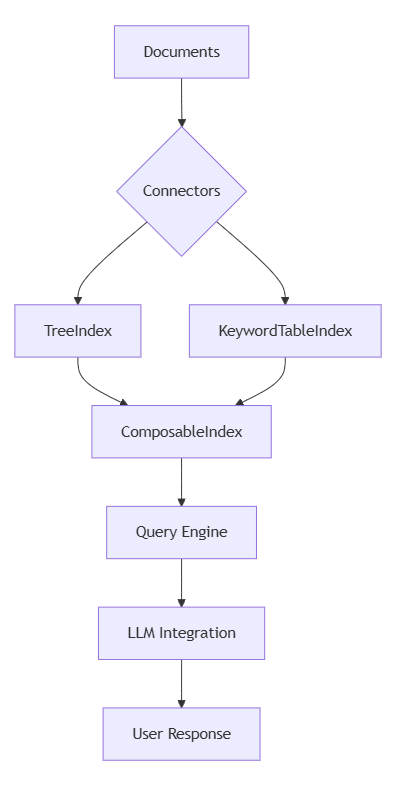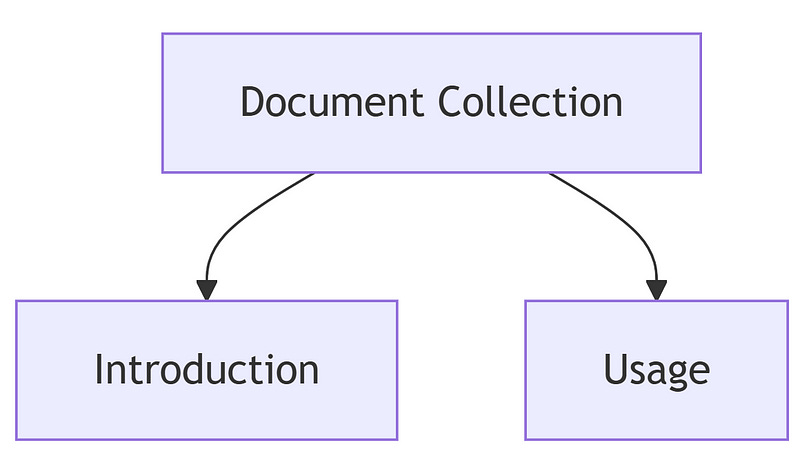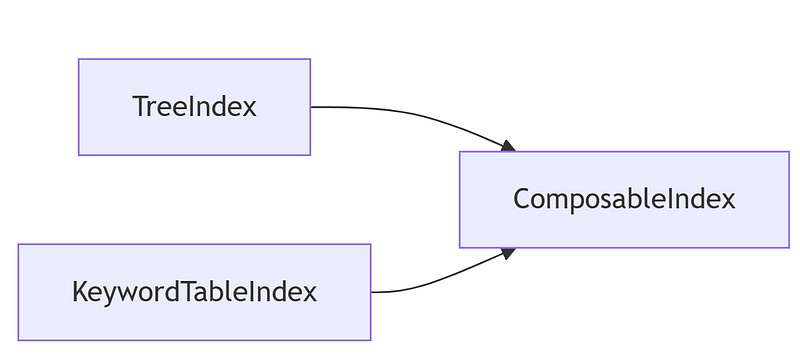Advanced LlamaIndex: Building Intelligent Applications
Tested with LlamaIndex v0.10.0 — Requires Python 3.8+
Imagine transforming your LLM applications from basic demos into production-grade systems that deliver lightning-fast, context-aware responses. In this article, we explore advanced techniques with LlamaIndex—unpacking sophisticated indexing, refined query strategies, and powerful integrations with external systems like vector databases and LangChain. Whether you’re aiming to build an intelligent chatbot or a high-performance semantic search engine, this guide will empower you with the tools and best practices to build truly robust applications. Let’s dive in!
Deep Dive into Advanced Indexes
Advanced indexing lies at the heart of high-performance applications. We’ll explore three powerful index types that enable flexible and efficient data retrieval.
TreeIndex
TreeIndex structures data hierarchically. It creates a tree-like representation, ideal for organizing nested or multi-level documents. TreeIndex
TreeIndex structures data hierarchically. It creates a tree-like representation, ideal for organizing nested or multi-level documents.
from llama_index.core import Document, TreeIndex
# Create Document objects for each section
sections = [Document(text="Introduction"), Document(text="Usage")]
tree_index = TreeIndex.from_documents(sections)
print("TreeIndex created with", len(sections), "sections")Under the hood, TreeIndex builds a node-based structure where each node represents a section, allowing for efficient tree traversals during queries.
KeywordTableIndex
KeywordTableIndex focuses on indexing by key terms, making it excellent for targeted searches.
from llama_index.core import Document, KeywordTableIndex
# Create Document objects for keywords
keywords = [Document(text="contract"), Document(text="liability"), Document(text="warranty")]
keyword_index = KeywordTableIndex.from_documents(keywords)
print("KeywordTableIndex created with", len(keywords), "keywords")How it works: Internally, it maps keywords to document references for fast lookup during query matching.
ComposableIndex
ComposableIndex combines the strengths of multiple index types. This hybrid approach allows you to use both hierarchical and keyword-based searching in a single, powerful index.
from llama_index.core import TreeIndex, KeywordTableIndex, ComposableIndex
tree_index = TreeIndex.from_documents([Document(text="Section A"), Document(text="Section B")])
keyword_index = KeywordTableIndex.from_documents([Document(text="Key A"), Document(text="Key B")])
composable_index = ComposableIndex(indexes=[tree_index, keyword_index])
print("ComposableIndex created with", len(composable_index.indexes), "sub-indexes")Advanced Querying Techniques
Refining your query methods is crucial for extracting the most relevant data. Advanced querying techniques include combining various search strategies and custom logic.
Combining Indexes for Hybrid Search
By integrating results from different index types, you can achieve a more nuanced search.
# Using composable index to process a hybrid query
query_engine = composable_index.as_query_engine()
results = query_engine.query("Key A")
print("Hybrid Query Results:", results)Custom Query Logic
Custom query logic lets you tailor searches to your specific needs—adjusting weights or applying post-processing to filter results.
def custom_query_logic(index, query, boost_factor=1.5):
# Example: Append a boost factor to the query string to influence search ranking
modified_query = f"{query} (boost {boost_factor})"
results = index.search(modified_query)
return results
# Assume vector_index is defined from earlier examples
custom_results = custom_query_logic(vector_index, "important topic")
print("Custom Query Results:", custom_results)Under the hood: Custom logic can adjust weights and merge results from multiple engines to enhance retrieval accuracy.
LlamaIndex and LLMs: Enhanced Context Management
LLMs thrive on context. LlamaIndex bridges the gap between raw data and LLM input by providing structured, context-rich information.
Managing Token Limits and Context window sizes
LLMs have strict token limits. LlamaIndex allows you to set chunk sizes (e.g., 512 tokens) to ensure the provided context fits within the model’s window, preventing truncation.
# Example of retrieving context and handling token limits
retrieved_context = "Key support document details that are critical for the query..."
custom_prompt = f"Using the following context:\n{retrieved_context}\nAnswer the customer query."
print(custom_prompt)Customizing Prompts for Dynamic Context
Dynamically tailor your prompts to include the most relevant context, ensuring your LLM generates accurate and comprehensive responses.
Integrations with External Systems
Modern applications often require seamless integration with external platforms. Here, we cover vector databases and LangChain.
Vector Database Integration
Vector databases (like Pinecone) store embeddings and enable fast similarity searches. First, generate embeddings using an embedding model.
from llama_index.embeddings.openai import OpenAIEmbedding
embed_model = OpenAIEmbedding()
embeddings = embed_model.get_text_embedding_batch(documents) # 'documents' from previous sections
# Integrate with Pinecone (example)
from pinecone import init, Index
init(api_key="YOUR_PINECONE_API_KEY", environment="us-west1-gcp")
pinecone_index = Index("llamaindex-vector")
# Upload embeddings to Pinecone
for doc, embedding in zip(documents, embeddings):
pinecone_index.upsert(vectors={doc.id: embedding})
print("Embeddings uploaded to Pinecone")LangChain Integration
LangChain streamlines complex LLM workflows. Here’s a detailed example using LangChain v0.1+ syntax.
from langchain.chains import LLMChain
from langchain.prompts import PromptTemplate
prompt = PromptTemplate(input_variables=["context"], template="Your prompt: {context}")
chain = LLMChain(llm=llm, prompt=prompt) # Assume 'llm' is your language model instance (e.g., GPT-4)
response = chain.run(context=retrieved_context)
print("LangChain Response:", response)Building a Real-World Application (Part 1): Chatbot over Documents
Let’s put these techniques into practice by building a sophisticated chatbot.
Data Ingestion
Load documents from multiple sources with proper preprocessing and ethical web scraping.
from llama_index.core import FileDataConnector, Document
try:
file_connector = FileDataConnector(file_path="data/docs.txt")
documents = file_connector.load_data() # Ensure conversion to Document objects
print("Documents Loaded:", documents)
except Exception as e:
print("Error loading documents:", e)Advanced Indexing for Chatbot
Combine advanced indexes for optimal data retrieval in your chatbot backend.
from llama_index.core import ListIndex, TreeIndex, ComposableIndex
list_index = ListIndex.from_documents(documents)
tree_index = TreeIndex.from_documents(documents)
composite_index = ComposableIndex(indexes=[list_index, tree_index])
print("Composite Index created with", len(composite_index.indexes), "sub-indexes")Performance Optimization, Testing, and Deployment
For production-grade applications, robust performance, testing, and security are essential.
Chunking and Batch Processing
Split large documents into manageable nodes to optimize processing.
from llama_index.core.node_parser import SentenceSplitter
splitter = SentenceSplitter(chunk_size=512)
nodes = splitter.get_nodes_from_documents(documents)
print("Nodes created:", len(nodes))Error Handling and Logging
Implement try/catch blocks and enable logging for better debugging.
import logging
logging.basicConfig(level=logging.INFO)Token Management
Implement strategies to manage token limits, ensuring that LLMs receive complete context without truncation.
Testing and Deployment
Implement unit, integration, and end-to-end tests. Consider containerization (using Docker) or serverless deployment strategies for scalable, secure applications. Protect API keys and sanitize inputs to prevent security vulnerabilities.
Hands-on Exercises
Challenge yourself with these exercises:
Exercise 1: Integrate a vector database (e.g., Weaviate) and benchmark search latency.
Exercise 2: Modify your custom query logic to merge keyword and vector-based results.
Exercise 3: Build a mini LangChain workflow that chains LlamaIndex retrieval with an LLM response.
Exercise 4: Enhance the chatbot by integrating data from multiple sources (local files, APIs, web scraping).
Exercise 5: Benchmark different index configurations and document performance metrics.
Access our GitHub repository for starter code and solutions.
Key Takeaways and Next Steps
Advanced Indexing Techniques: Leverage TreeIndex, KeywordTableIndex, and ComposableIndex for flexible, powerful data organization.
Refined query strategies: utilize hybrid and custom query logic for precise, context-rich searches.
Enhanced LLM Integration: LlamaIndex improves LLM performance by managing token limits and delivering structured context.
Seamless External Integrations: Vector databases and LangChain enable scalable, production-grade applications.
Production Best Practices: Implement robust error handling, performance optimizations, testing, and secure deployment strategies.
Next Steps:
Prepare for a final production-grade project where you refine the chatbot, integrate user feedback, and deploy using containerized or serverless solutions.
Conclusion
LlamaIndex is not just an indexing tool—it's a comprehensive framework for building intelligent, scalable applications. By employing advanced indexing, refined query logic, and seamless integrations with vector databases and LangChain, you can build systems that deliver precise, high-performance results. For instance, a healthcare startup reduced clinical trial search times by 65% using LlamaIndex integrated with Pinecone. Join our community on Discord, explore our GitHub repository, and start building your next breakthrough application today!
Author Bio:
I’m an experienced developer and data engineer specializing in LLM application development. My contributions to the LlamaIndex community have driven real-world innovations, and I’m passionate about sharing advanced techniques with fellow developers. Connect with me on GitHub and join our Discord community for collaborative learning and support.
Call to Action:
Dive into the LlamaIndex documentation, experiment with these advanced techniques, and share your projects on our community forum. Download our free Production Readiness Checklist and join our challenge project to win prizes for the best implementation!
Further Reading:
LlamaIndex Documentation
FAQs
What advanced index types does LlamaIndex offer?
LlamaIndex supports advanced indexes such as TreeIndex for hierarchical data, KeywordTableIndex for targeted searches, and ComposableIndex to combine multiple indexing methods for hybrid retrieval.How can I refine my queries using advanced techniques?
By combining different query engines and applying custom logic—such as merging keyword and vector-based results—you can achieve context-aware and precise search outputs.How does LlamaIndex enhance LLM performance?
It structures data into context-rich formats, manages token limits through intelligent chunking, and customizes prompts to ensure LLMs receive complete, relevant information.What is the role of vector databases in LlamaIndex integrations?
Vector databases like Pinecone or Weaviate store vector embeddings efficiently, enabling fast similarity searches and scalable semantic retrieval when integrated with LlamaIndex.How does LangChain integrate with LlamaIndex?
LangChain streamlines LLM workflows by chaining components together. With the updated v0.1+ syntax, you can integrate LlamaIndex retrieval with advanced LLM processing for tasks such as Q&A and summarization.
Solutions to Exercises
Exercise 1: Integrate a vector database (e.g., Weaviate) and benchmark search latency
import weaviate
import time
from llama_index.embeddings.openai import OpenAIEmbedding
from llama_index.core import Document
# Connect to Weaviate instance (assumed to be running locally)
client = weaviate.Client("http://localhost:8080")
# Example documents (ensure these are Document objects)
documents = [Document(text="Document one content"), Document(text="Document two content")]
# Generate embeddings for each document
embed_model = OpenAIEmbedding()
embeddings = embed_model.get_text_embedding_batch([doc.text for doc in documents])
# Create Weaviate schema for Documents if not already present
schema = {
"classes": [
{
"class": "Document",
"properties": [
{"name": "text", "dataType": ["text"]}
]
}
]
}
if not client.schema.contains(schema):
client.schema.create(schema)
# Upload documents with embeddings to Weaviate
for doc, emb in zip(documents, embeddings):
data_object = {"text": doc.text}
client.data_object.create(data_object, "Document", vector=emb)
# Benchmark search latency
start_time = time.time()
# Generate embedding for the query
query_embedding = embed_model.get_text_embedding("sample query")
result = client.query.get("Document", ["text"]).with_near_vector({"vector": query_embedding, "certainty": 0.7}).do()
latency = time.time() - start_time
print("Weaviate search latency: {:.2f} seconds".format(latency))Exercise 2: Modify your custom query logic to merge keyword and vector-based results
def merged_query_logic(vector_index, keyword_index, query, vector_weight=0.7, keyword_weight=0.3):
# Perform vector-based search
vector_results = vector_index.search(query)
# Perform keyword-based search
keyword_results = keyword_index.search(query)
# Merge results using a weighted sum of scores
combined_scores = {}
for res in vector_results:
combined_scores[res.id] = vector_weight * res.score
for res in keyword_results:
if res.id in combined_scores:
combined_scores[res.id] += keyword_weight * res.score
else:
combined_scores[res.id] = keyword_weight * res.score
# Sort results by combined score
sorted_results = sorted(combined_scores.items(), key=lambda x: x[1], reverse=True)
return sorted_results
merged_results = merged_query_logic(vector_index, keyword_index, "important topic")
print("Merged Query Results:", merged_results)Exercise 3: Build a mini LangChain workflow that chains LlamaIndex retrieval with an LLM response
from langchain.chains import LLMChain
from langchain.prompts import PromptTemplate
# Create a prompt template using retrieved context
prompt = PromptTemplate(input_variables=["context"], template="Based on the following context:\n{context}\nAnswer the query:")
chain = LLMChain(llm=llm, prompt=prompt) # Assume 'llm' is your instantiated language model (e.g., GPT-4)
# Retrieve context using LlamaIndex query engine
retrieved_context = query_engine.query("What is the main idea of the document?")
# Run the LangChain workflow
response = chain.run(context=retrieved_context)
print("LangChain Workflow Response:", response)Exercise 4: Enhance the chatbot by integrating data from multiple sources (local files, APIs, web scraping)
from llama_index.core import FileDataConnector, APIDataConnector, WebDataConnector, Document
import requests
from bs4 import BeautifulSoup
# Load local file documents
local_connector = FileDataConnector(file_path="data/local_docs.txt")
local_docs = local_connector.load_data()
# Load API data (example: financial data API)
try:
api_response = requests.get("https://api.example.com/financial-data")
api_response.raise_for_status()
api_data = api_response.json()
api_connector = APIDataConnector(data=api_data)
api_docs = api_connector.load_data()
except Exception as e:
print("API Error:", e)
api_docs = []
# Load web scraped data
url = "https://example.com/articles"
headers = {"User-Agent": "Mozilla/5.0"}
try:
response = requests.get(url, headers=headers)
response.raise_for_status()
soup = BeautifulSoup(response.text, "html.parser")
web_data = soup.get_text()
web_connector = WebDataConnector(data=web_data)
web_docs = web_connector.load_data()
except Exception as e:
print("Web Scraping Error:", e)
web_docs = []
# Combine documents from all sources
all_docs = local_docs + api_docs + web_docs
# Create an index for the chatbot
from llama_index.core import ListIndex
chatbot_index = ListIndex.from_documents(all_docs)
print("Chatbot Index created with", len(all_docs), "documents")Exercise 5: Benchmark different index configurations and document performance metrics
import time
from llama_index.core import ListIndex, TreeIndex, VectorStoreIndex
# Benchmark ListIndex creation
start = time.time()
list_index = ListIndex.from_documents(documents)
list_index_time = time.time() - start
# Benchmark TreeIndex creation
start = time.time()
tree_index = TreeIndex.from_documents(documents)
tree_index_time = time.time() - start
# Benchmark VectorStoreIndex creation with chunking
start = time.time()
vector_index = VectorStoreIndex.from_documents(documents, chunk_size=512)
vector_index_time = time.time() - start
print("ListIndex creation time: {:.2f} seconds".format(list_index_time))
print("TreeIndex creation time: {:.2f} seconds".format(tree_index_time))
print("VectorStoreIndex creation time: {:.2f} seconds".format(vector_index_time))For further discussion, collaboration, or to access our full GitHub repository with well-documented code, please contact us with a direct message








